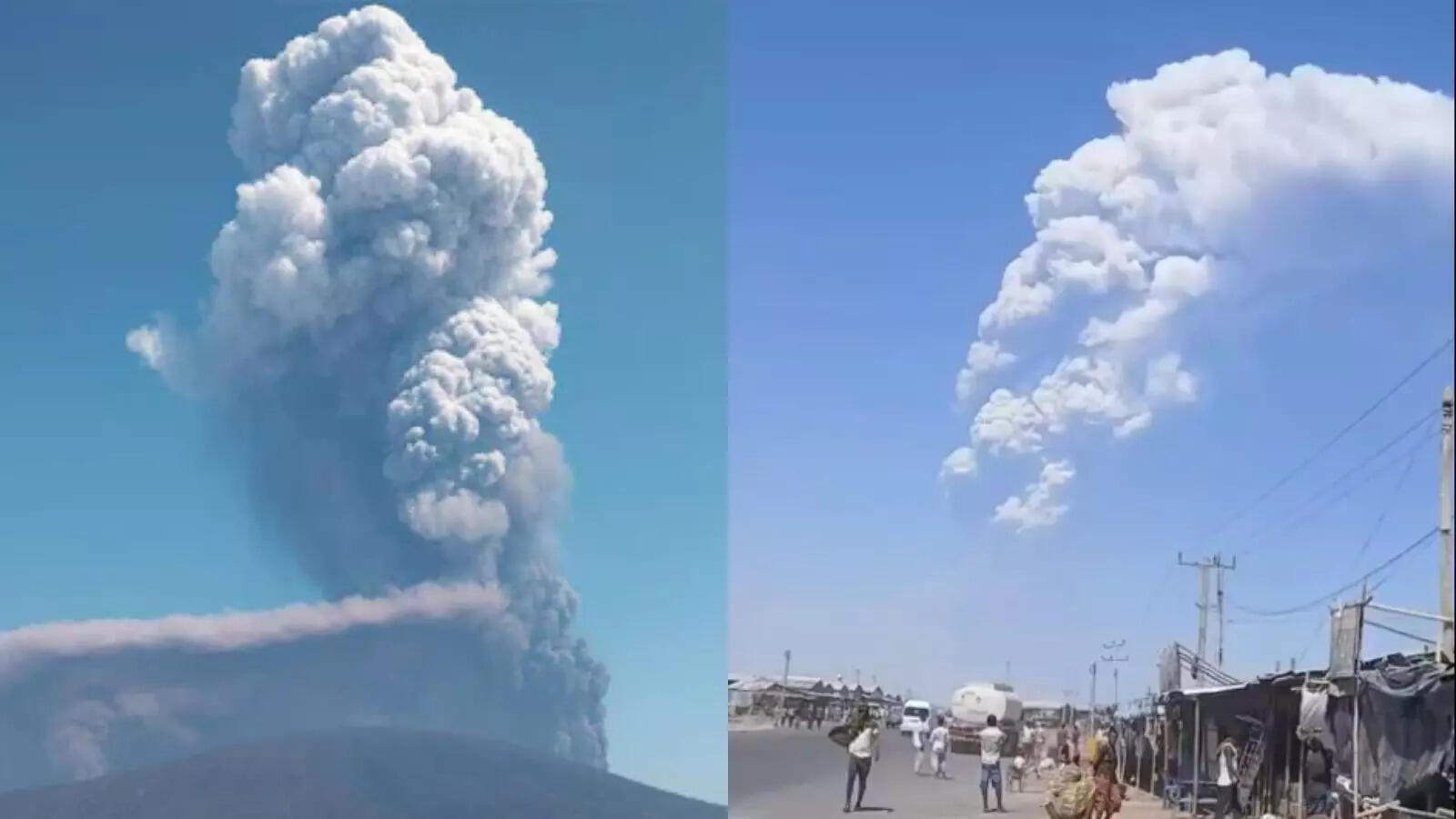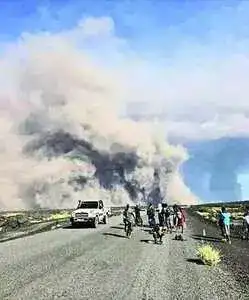Why Flights Can’t Fly Above Volcanic Ash: The Ethiopia-to-Delhi Plume Explained
In November 2025, Ethiopia’s Hayli Gubbi volcano surprised experts with a powerful eruption after millennia of inactivity. The event produced a towering ash plume that quickly became the focus of global monitoring systems, as researchers mapped its climb into high-altitude wind corridors.
Within hours, satellite data and atmospheric modelling from NOAA’s HYSPLIT system showed the plume drifting rapidly eastward. Strong upper-level winds carried it over the Arabian Peninsula, pushing it more than 4,000 km toward India in just 48–72 hours. This raised a question on many minds: Why can’t aircraft simply fly over or around an ash cloud? And how long do such plumes remain a concern?
Volcanic ash is nothing like smoke. The US Geological Survey (USGS) points out that ash contains sharp, abrasive particles of volcanic glass and pulverized rock. When these enter a jet engine, the extreme heat melts the particles into a glassy coating that blocks airflow and can cause total engine failure. The danger is not theoretical two major incidents, British Airways Flight 9 (1982) and KLM Flight 867 (1989), saw all engines flame out after flying into ash clouds.
2. Ash Is Invisible to Aircraft Radar
Unlike storms or clouds, volcanic ash contains no moisture. ICAO’s Volcanic Ash Operations Manual states clearly that onboard radar “cannot detect volcanic ash,” leaving pilots effectively blind to its presence. This is why global satellite monitoring systems NOAA, EUMETSAT, and regional VAACs play a critical role in issuing real-time warnings.
NASA’s aviation safety research highlights that ash particles can sandblast cockpit windows, infiltrate fuel systems, contaminate air filters, and corrode aircraft surfaces. Over time, this can weaken structural integrity. Because these risks accumulate even at low concentrations, aviation authorities impose no-fly zones the moment ash is detected.

How Ethiopia’s Ash Plume Travelled 4,000 km to India
The Hayli Gubbi eruption sent ash into the upper troposphere and lower stratosphere altitudes where winds are far more powerful than those near the ground. NOAA’s Global Forecast System (GFS) and NASA’s GEOS models recorded strong eastward jet-stream winds of 100–160 km/h over the Horn of Africa during the eruption period.

Data from the Smithsonian Institution’s Global Volcanism Program and dispersion models from Toulouse VAAC show:
The Hayli Gubbi eruption is classified as VEI 3. NASA climate experts confirm that eruptions of this scale are too small to affect global temperatures or weather patterns, unlike massive eruptions such as Mount Pinatubo in 1991 (VEI 6).
For aviation, the lesson remains simple: volcanic ash is one of the few hazards that modern aircraft cannot safely navigate. When ash is present, the only safe option is to avoid it entirely.

Within hours, satellite data and atmospheric modelling from NOAA’s HYSPLIT system showed the plume drifting rapidly eastward. Strong upper-level winds carried it over the Arabian Peninsula, pushing it more than 4,000 km toward India in just 48–72 hours. This raised a question on many minds: Why can’t aircraft simply fly over or around an ash cloud? And how long do such plumes remain a concern?
Why Flights Cannot Risk Flying Over Volcanoes
1. Ash Can Shut Down a Jet Engine in Under 60 Seconds
Volcanic ash is nothing like smoke. The US Geological Survey (USGS) points out that ash contains sharp, abrasive particles of volcanic glass and pulverized rock. When these enter a jet engine, the extreme heat melts the particles into a glassy coating that blocks airflow and can cause total engine failure. The danger is not theoretical two major incidents, British Airways Flight 9 (1982) and KLM Flight 867 (1989), saw all engines flame out after flying into ash clouds.
2. Ash Is Invisible to Aircraft Radar
Unlike storms or clouds, volcanic ash contains no moisture. ICAO’s Volcanic Ash Operations Manual states clearly that onboard radar “cannot detect volcanic ash,” leaving pilots effectively blind to its presence. This is why global satellite monitoring systems NOAA, EUMETSAT, and regional VAACs play a critical role in issuing real-time warnings. 3. Even Thin Ash Can Cause Long-Term Aircraft Damage
NASA’s aviation safety research highlights that ash particles can sandblast cockpit windows, infiltrate fuel systems, contaminate air filters, and corrode aircraft surfaces. Over time, this can weaken structural integrity. Because these risks accumulate even at low concentrations, aviation authorities impose no-fly zones the moment ash is detected.

How Ethiopia’s Ash Plume Travelled 4,000 km to India
The Hayli Gubbi eruption sent ash into the upper troposphere and lower stratosphere altitudes where winds are far more powerful than those near the ground. NOAA’s Global Forecast System (GFS) and NASA’s GEOS models recorded strong eastward jet-stream winds of 100–160 km/h over the Horn of Africa during the eruption period. 
Data from the Smithsonian Institution’s Global Volcanism Program and dispersion models from Toulouse VAAC show:
- Ash plumes above 10–12 km can cross continents with ease
- Fine ash can remain aloft for several days before settling
- The atmospheric setup in November created a direct path toward South Asia
- This combination allowed the ash to travel rapidly, despite originating thousands of kilometres away.
How Long Will the Influence Last?
Upper Atmosphere: 1–3 Days of Mild, High-Altitude Effects
NOAA’s HYSPLIT and NASA’s aerosol models indicate that the ash layer reaching Indian skies is highly diluted. It will remain confined to upper layers of the atmosphere, posing no threat to ground-level air quality. People may notice slightly hazier skies or deeper orange sunsets. Long-haul aircraft might alter their routes or cruising altitudes as a precaution.Residual Traces: Up to 1–2 Weeks
Fine ash can linger in the stratosphere long after it becomes invisible to the naked eye. Satellite instruments like MODIS, CALIPSO, and VIIRS may detect residual particles for several days.
Climate Impact: None
The Hayli Gubbi eruption is classified as VEI 3. NASA climate experts confirm that eruptions of this scale are too small to affect global temperatures or weather patterns, unlike massive eruptions such as Mount Pinatubo in 1991 (VEI 6).A Wake-Up Call From a “Sleeping” Volcano
The Hayli Gubbi eruption offers a clear reminder that dormant volcanoes can awaken suddenly and that even moderate eruptions can disrupt international airspace thousands of kilometres away. Scientists at USGS and the Smithsonian emphasise that East Africa’s tectonic rift system is highly active, and volcanoes in the region may erupt more frequently in coming decades.For aviation, the lesson remains simple: volcanic ash is one of the few hazards that modern aircraft cannot safely navigate. When ash is present, the only safe option is to avoid it entirely.
Next Story